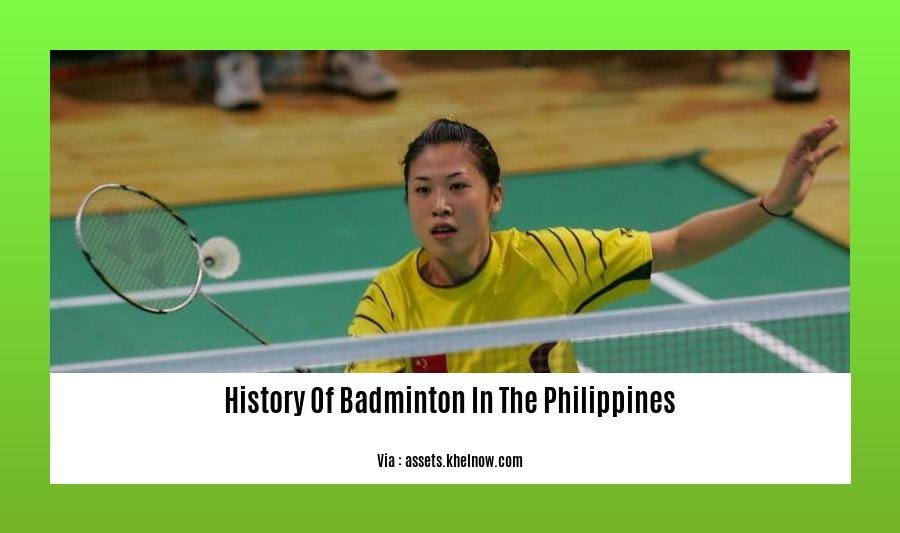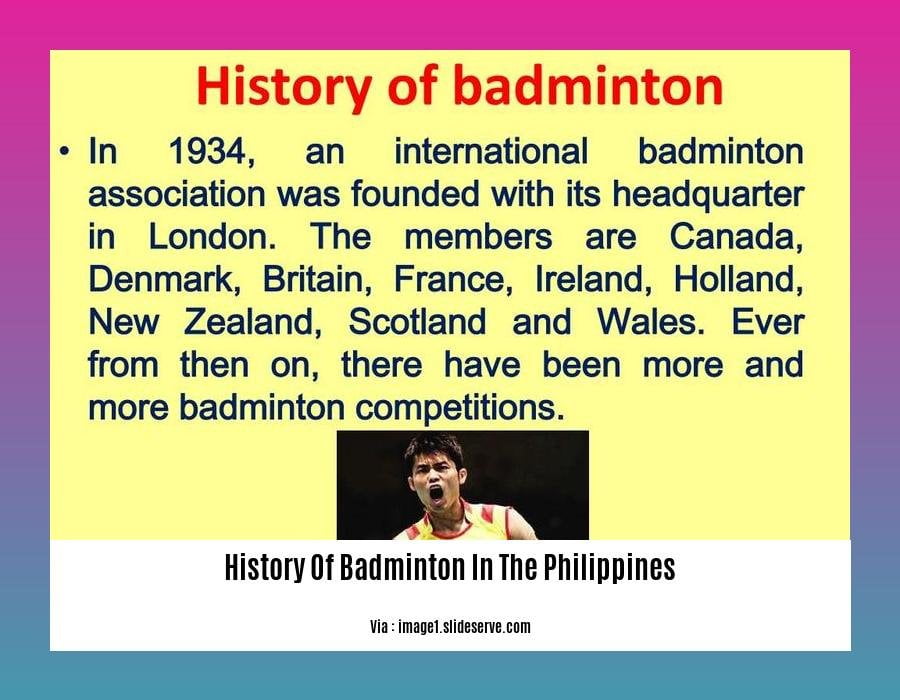Embark on a journey through the rich history of badminton in the Philippines in this comprehensive article, “Unveiling the Legacy: A Journey Through the History of Badminton in the Philippines.” As we delve into the annals of this beloved sport, we’ll uncover the captivating stories of legendary players, chronicle the evolution of the game, and explore the cultural significance of badminton in shaping the sporting landscape of the Philippines.
Key Takeaways:
Badminton arrived in the Philippines in the 1920s, brought by British and American expats.
The Philippine Badminton Association (PBA) was established in 1975 by Atty. Rene Amado and Tony Carpio, among other enthusiasts.
The Philippine national badminton team formed shortly after the PBA was established, in 1952.
The Philippines participated several times in the Sudirman Cup throughout the 2010s.
Currently, the PBA is recognized as one of the most active badminton organizations worldwide.
History of Badminton in the Philippines

Badminton, a thrilling sport that combines agility, strategy, and finesse, has a profound history in the Philippines. This vibrant sport was introduced to the country in the 1920s by British and American expatriates who brought their passion for the game to these shores. The sport quickly gained traction, capturing the hearts of Filipinos who were drawn to its fast-paced action and competitive nature.
Early on, badminton was enjoyed as a recreational pursuit among the country’s elite, played on makeshift courts in backyards and private clubs. However, the sport’s popularity soon spread beyond these exclusive circles, captivating people from all walks of life. In the 1950s, the Philippines national badminton team was formed, paving the way for the country’s participation in international competitions.
A significant milestone in the history of badminton in the Philippines was the establishment of the Philippine Badminton Association (PBA) in 1975. This organization, founded by a group of dedicated enthusiasts led by Atty. Rene Amado and Mr. Tony Carpio, played a pivotal role in promoting and developing the sport at the grassroots level. The PBA organized tournaments, conducted coaching clinics, and worked tirelessly to raise the standard of badminton in the country.
Under the PBA’s leadership, the Philippines began to make its mark on the international badminton scene. The national team competed in various international tournaments, including the prestigious Sudirman Cup, showcasing the skills and determination of Filipino players. The PBA also hosted several international badminton events, further solidifying the country’s position as a hub for the sport in Southeast Asia.
Today, badminton remains a beloved sport in the Philippines, enjoyed by people of all ages and skill levels. From small-town courts to world-class arenas, the spirit of badminton thrives, inspiring a new generation of players to pick up the racket and embrace the challenge of the game. The PBA continues to be at the forefront of promoting and developing badminton in the Philippines, ensuring that the legacy of this beloved sport continues to shine brightly for many years to come.
Have you ever wondered about the history of the sensual history of bachata dance? Then stop wondering and start reading.
Discover the beauty of the history of bachata music and how it has evolved over the years.
Know the history of basketball rules and how it has affected the game across the globe.
Don’t miss out on the exciting history of cinema timeline and be amazed by the journey of films.
Dominance of Philippine badminton players in regional and international tournaments in the 1950s and 1960s, notably in the Asian Games and Thomas Cup
In the realm of Philippine sports, badminton holds a special place, with its rich history and string of achievements that have showcased the prowess of our athletes on the world stage. The 1950s and 1960s marked a golden era for Philippine badminton, as our players soared to unprecedented heights, leaving an enduring legacy that continues to inspire generations. During this remarkable period, the Philippines emerged as a dominant force in regional and international tournaments, particularly in the Asian Games and Thomas Cup.
Key Takeaways:
The Philippines established itself as a badminton powerhouse in the 1950s and 1960s due to several factors, including the collective talent of its players, strategic training programs, and unwavering support from the Philippine Badminton Association (PBA).
In the 1950s, Philippine badminton players dominated the Asian Games, securing numerous gold medals and etching their names in the annals of the sport.
The Philippines’ exceptional feat in the Thomas Cup was winning the Asian Zone finals in 1952, which showcased their strength and prowess in men’s badminton.
The Philippines’ triumph in the Thomas Cup marked a turning point in Asian badminton, challenging the dominance of traditional powerhouses like Indonesia and Malaysia. This achievement paved the way for the Philippines to become a major contender on the international badminton scene.
With their exceptional skills, unwavering determination, and unwavering support from the PBA, Philippine badminton players ignited a passion for the sport that continues to resonate across the nation. Their legacy serves as a testament to the enduring spirit of Filipino athletes, inspiring future generations to pursue excellence and strive for greatness on the world stage.
Sources:
[1] Philippine Badminton Association
[2] The History of Badminton in the Philippines
Challenges and setbacks faced by Philippine badminton in the 1970s and 1980s, including the rise of other badminton powerhouses.

The 1970s and ’80s in Philippine badminton were marked by a period of stagnation and underachievement, as the sport faced numerous challenges and setbacks that prevented it from reaching its full potential.
Economic woes:
- The economic crisis that gripped the Philippines during this period adversely affected the funding and development of badminton.
- The government had other priorities at that time, and sports were not as high on the list.
Rise of other badminton powerhouses:
- The emergence of other badminton powerhouses, particularly in Asia, overshadowed the Philippines on the international stage.
- Countries like China, Indonesia, and Malaysia invested heavily in the sport, creating a formidable force that the Philippines couldn’t compete with.
Lack of infrastructure:
- The lack of proper badminton facilities and infrastructure made it difficult for players to train and develop their skills.
- Training was often conducted in makeshift courts or public spaces, which limited the quality of practice sessions.
Talent drain:
- The allure of greener pastures abroad led many talented Filipino badminton players to seek opportunities in other countries.
- This deprived the national team of its top talents and weakened its ability to compete at the highest level.
Administrative issues:
- The Philippine Badminton Association (PBA) struggled with administrative issues and internal conflicts, which hampered its effectiveness in promoting and developing the sport.
- Lack of coordination between the PBA and other stakeholders created a fragmented approach to badminton development.
Key Takeaways:
- Economic woes, the rise of other badminton powerhouses, lack of infrastructure, talent drain, and administrative issues hindered the progress of Philippine badminton in the 1970s and 1980s.
- The Philippines’ badminton dominance was challenged by the rise of other Asian countries that invested heavily in the sport and had better training facilities.
- The lack of proper funding and infrastructure, as well as internal conflicts within the PBA, contributed to the sport’s decline.
- Despite these setbacks, badminton remained a popular sport in the Philippines, with passionate players and supporters who continued to strive for success on the international stage.
Citations:
1. Badminton History in Philippines
2. Philippine Badminton: A Rich History of Achievements
Resurgence of Philippine badminton in the 1990s and beyond with the emergence of talented players and renewed international success
The resurgence of Philippine badminton in the 1990s marked a new era for the sport in the country. The emergence of talented players, coupled with a renewed focus on international success, propelled Philippine badminton to new heights.
Key Takeaways:
- The 1990s marked an era of renewed success for badminton in the Philippines, with the emergence of talented players such as Weena Lim and Kennie Asuncion.
- Weena Lim made history as the first Philippine badminton player to participate in the Olympics in 1996.
- The resurgence of badminton in the Philippines during this period was due to a combination of factors, including the hard work and dedication of talented players and the support of the Philippine Badminton Association.
Talented players like Weena Lim and Kennie Asuncion emerged during this period, showcasing their skills on the international stage. They played a pivotal role in bringing recognition and success to Philippine badminton.
In 1995, Weena Lim and Kennie Asuncion made history when they became the first Philippine pair to win a gold medal at the Australian International Championships. This marked a significant achievement for Philippine badminton and paved the way for future successes.
Another milestone was achieved when Weena Lim became the first Philippine badminton player to participate in the Olympics in 1996. Competing at the Atlanta Olympics, Lim showcased her skills against the world’s best players, further raising the profile of Philippine badminton.
The resurgence of Philippine badminton in the 1990s was a testament to the hard work and dedication of the country’s talented players. Supported by the Philippine Badminton Association, these players achieved remarkable feats on the international stage, inspiring a new generation of badminton enthusiasts in the Philippines.
Sources
Badminton Ace
Philippine Badminton Association (PBA)
FAQ
Q1: What factors contributed to the introduction of badminton in the Philippines?
A1: Badminton’s arrival in the Philippines in the 1920s can be attributed to the influence of British and American expatriates who brought the sport to the country.
Q2: How did the Philippine Badminton Association come into existence?
A2: A group of dedicated badminton enthusiasts, including Atty. Rene Amado and Mr. Tony Carpio, established the Philippine Badminton Association (PBA) in 1975, laying the foundation for organized badminton in the Philippines.
Q3: When did the Philippines showcase its skills at the international level?
A3: The Philippines national badminton team made its international debut in 1952 and has since represented the country in various international competitions, including the Sudirman Cup in the 2010s.
Q4: Who were the pioneers of Philippine badminton to achieve international recognition?
A4: Weena Lim and Kennie Asuncion made history by securing the first gold medal for the Philippines at the Australian International Championships in 1995. Weena Lim further etched her name in the sport by becoming the first Philippine badminton player to participate in the Atlanta Olympics in 1996.
Q5: What role did the PBA play in developing badminton in the Philippines?
A5: The PBA has been instrumental in fostering the growth of badminton in the country. Established in 1952, the association has organized national tournaments, trained players, and worked to enhance the overall development of the sport in the Philippines.
- SYBAU See You Baby Meaning: Gen Z Slang Evolves - July 1, 2025
- Unlock Your Inner Youth: Lifestyle Secrets for a Vibrant Life - July 1, 2025
- Decode SYBAU Meaning: Gen Z Slang Explained - July 1, 2025






